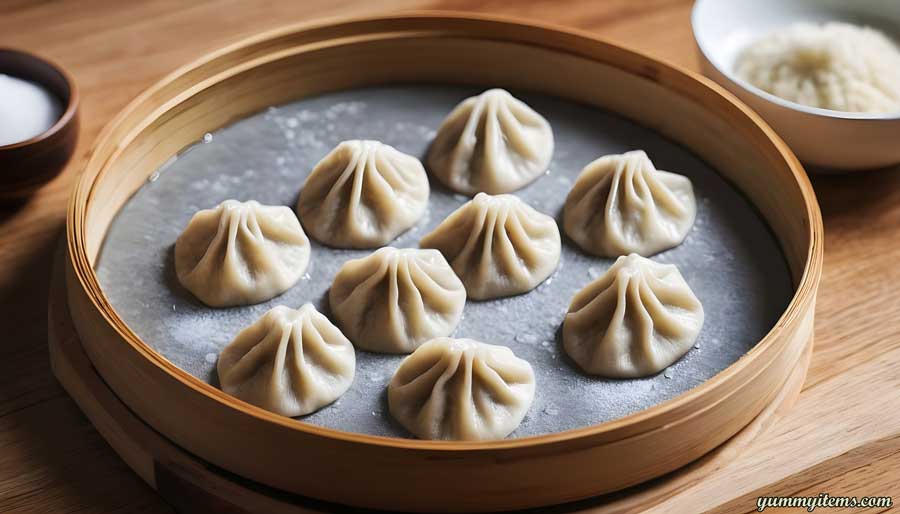Dumplings, those delightful pockets of dough filled with various savory or sweet fillings, are a beloved comfort food in many cultures around the world. While there are countless dumpling recipes out there that call for various ingredients and techniques, today, we’ll focus on a classic and versatile method of making dumplings using just two basic ingredients: flour and water.
Whether you’re a seasoned cook looking to expand your culinary skills or a novice in the kitchen, making dumplings from scratch is a rewarding experience. This comprehensive guide will take you through every step of the process, from preparing the dough to shaping and cooking your dumplings to perfection. So, let’s dive into the world of dumplings and uncover the secrets to creating delicious dumplings with flour and water.
1. Introduction
The Universal Appeal of Dumplings
Dumplings, known by various names such as potstickers, pierogi, gyoza, or momo, are a culinary wonder appreciated by people from diverse cultures. These little pockets of joy come in many shapes, sizes, and flavors, making them a versatile and satisfying dish. Whether you prefer them boiled, steamed, or pan-fried, dumplings are a comforting and heartwarming treat.
The Simplicity of Flour and Water Dumplings
While you can find dumplings made with a wide array of ingredients, we’ll focus on a simple and accessible approach using just flour and water. This basic recipe allows you to create dumplings from scratch with minimal effort and common kitchen staples. Whether you’re a seasoned chef or a novice cook, making dumplings with flour and water is a delightful and rewarding experience.
In the following sections, we’ll explore the step-by-step process of crafting these delectable dumplings from start to finish.
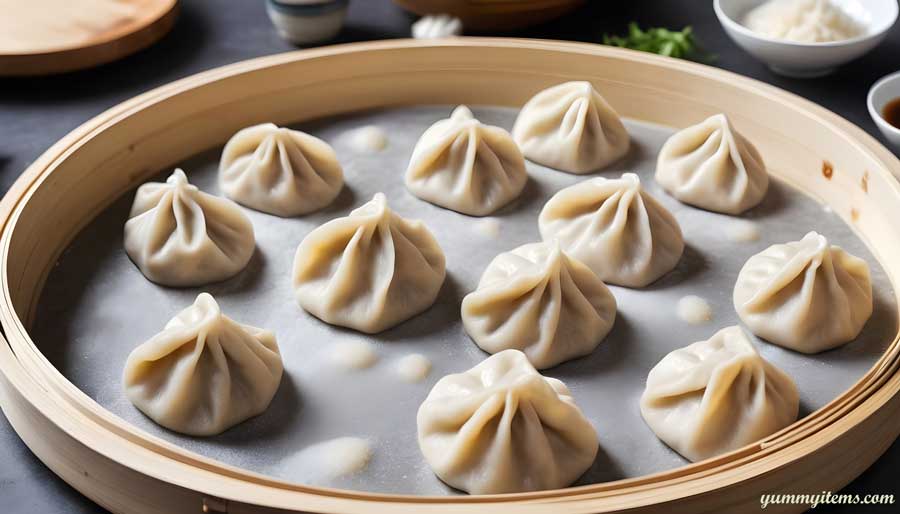
2. Gathering Your Ingredients and Tools
What You’ll Need
Before we embark on our dumpling-making journey, let’s ensure we have all the necessary ingredients and tools at hand. Making dumplings with flour and water doesn’t require fancy equipment, but a few essentials will make the process smoother:
Ingredients:
- All-purpose flour
- Water
Tools:
- Mixing bowl
- Rolling pin
- Knife or dumpling cutter
- Cutting board
- Clean kitchen towel or plastic wrap
Types of Flour to Use
The choice of flour can influence the texture of your dumplings. While all-purpose flour is the most common and versatile choice, you can experiment with different types of flour to achieve unique results:
- All-Purpose Flour: Provides a balanced texture for dumplings, suitable for most recipes.
- Cake Flour: Yields a softer and more delicate dumpling wrapper, ideal for delicate fillings.
- Whole Wheat Flour: Adds a nutty flavor and a denser texture to the wrappers, perfect for heartier fillings.
- Glutinous Rice Flour: Creates a chewy and sticky wrapper, commonly used in Asian dumplings like mochi.
Feel free to mix flours to achieve the texture and flavor you desire. A combination of all-purpose and cake flour, for instance, can produce dumplings with a wonderful balance of tenderness and structure.
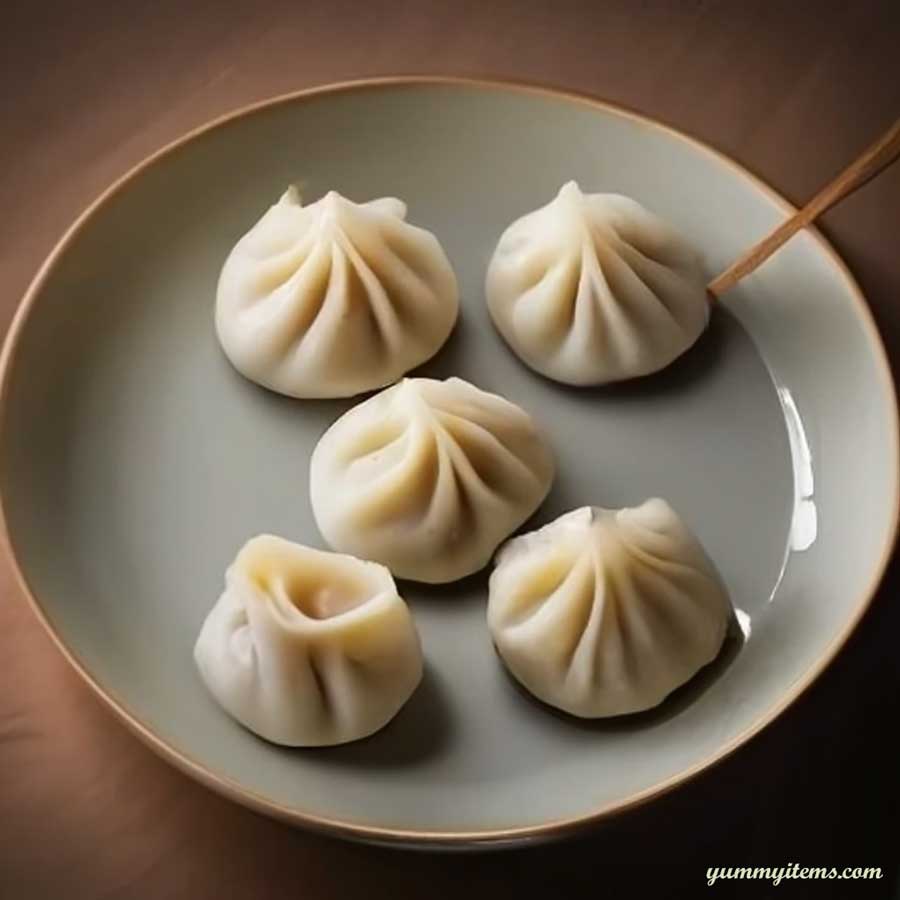
3. Making the Dough
The Basic Dough Recipe
Creating the perfect dumpling dough with just flour and water requires a careful balance of these two ingredients. Here’s a basic recipe to get you started:
Ingredients:
- 2 cups of all-purpose flour
- 3/4 cup of water (approximately)
Instructions:
- Measure the Flour: Start by measuring out 2 cups of all-purpose flour and placing it in a mixing bowl.
- Add Water Gradually: Begin adding water to the flour, a little at a time. Stir with a wooden spoon or your fingers as you go.
- Knead the Dough: Once the mixture starts coming together, use your hands to knead the dough in the bowl. Continue to add water slowly until you achieve a smooth and elastic dough. You may not need the entire 3/4 cup of water, so add it gradually to avoid making the dough too sticky.
- Rest the Dough: After kneading for about 5-7 minutes, shape the dough into a ball and cover it with a clean kitchen towel or plastic wrap. Let it rest at room temperature for at least 30 minutes. This resting period allows the dough to relax and become more pliable.
Now that you’ve prepared your dumpling dough, it’s time to move on to the next step: shaping the dumplings.
4. Resting the Dough
Importance of Dough Resting
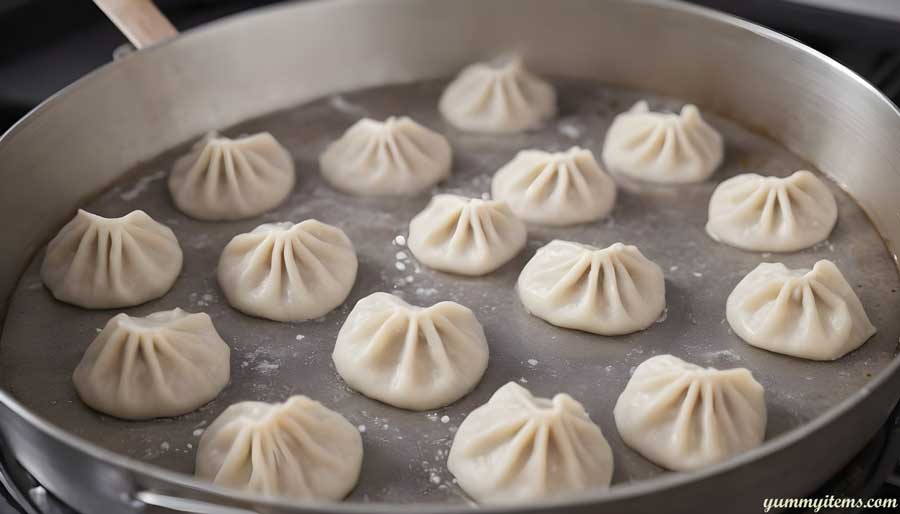
Resting the dumpling dough is a crucial step in the dumpling-making process. It serves several essential purposes:
- Relaxation: Resting allows the gluten in the dough to relax. This makes the dough easier to roll out and shape, preventing it from shrinking back when you try to stretch it.
- Texture: Resting contributes to a smoother, more cohesive texture in the dumpling wrappers. It gives the dough time to evenly absorb the moisture and ensures that the dumplings cook evenly.
- Flavor: Resting also enhances the flavor of the dough. Just like bread dough or pizza dough, the resting period allows the flour to fully hydrate, resulting in a better-tasting dumpling wrapper.
Resting Times and Conditions
While a minimum of 30 minutes is recommended for resting the dumpling dough, longer resting times can yield even better results. Some experienced dumpling makers rest their dough for several hours or even overnight in the refrigerator. This extended resting period can result in dumplings with exceptionally smooth and pliable wrappers.
Here are a few tips for dough resting:
- Cover Properly: Ensure that the dough is well-covered during resting to prevent it from drying out. You can use a clean kitchen towel or plastic wrap to cover the bowl.
- Room Temperature vs. Refrigeration: Resting at room temperature is common and works well. However, if you plan to rest the dough for an extended period, such as overnight, refrigerate it to slow down the fermentation process. Remember to allow the dough to come to room temperature before shaping the dumplings.
Now that our dough has had time to rest and relax, it’s time to move on to the exciting part: shaping dumplings.
5. Shaping Dumplings
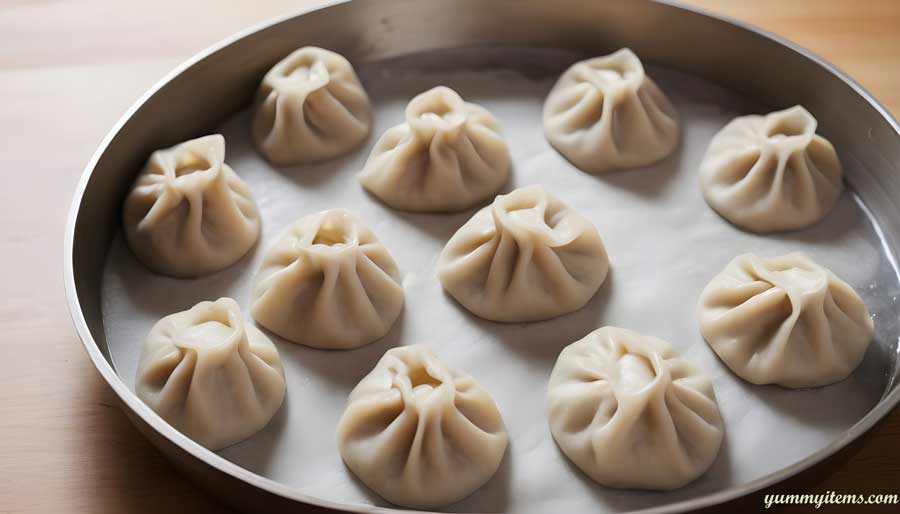
Shaping dumplings is where your creativity can truly shine. Whether you prefer classic pleats, simple half-moons, or intricate designs, the choice is yours. Here, we’ll cover the basics of rolling out dumpling wrappers and explore a few popular folding techniques.
Rolling Out Dumpling Wrappers
Ingredients and Tools:
- Rested dumpling dough
- Rolling pin
- Dumpling cutter or knife
Instructions:
- Divide the Dough: Start by dividing the rested dumpling dough into manageable portions. You can use a knife to cut the dough into smaller pieces, about the size of a walnut.
- Shape into Balls: Take each piece of dough and roll it between your palms to create a smooth ball.
- Flatten the Dough: With the palm of your hand, gently flatten the dough ball into a small disk.
- Roll Out the Wrapper: Begin rolling out the dough into a thin, round wrapper. Start in the center and work your way outward, rotating the dough as you go. Aim for a wrapper that’s about 3-4 inches in diameter for smaller dumplings and 4-5 inches for larger ones.
- Ensure Even Thickness: Pay attention to the thickness of the wrapper as you roll it out. You want it to be thin and even, with slightly thinner edges.
- Cut the Wrapper: Once the wrapper is the desired size and thickness, use a dumpling cutter or knife to cut out a perfect circle.
Now that you’ve prepared your dumpling wrappers, let’s explore some popular folding and filling options.
6. Filling Options
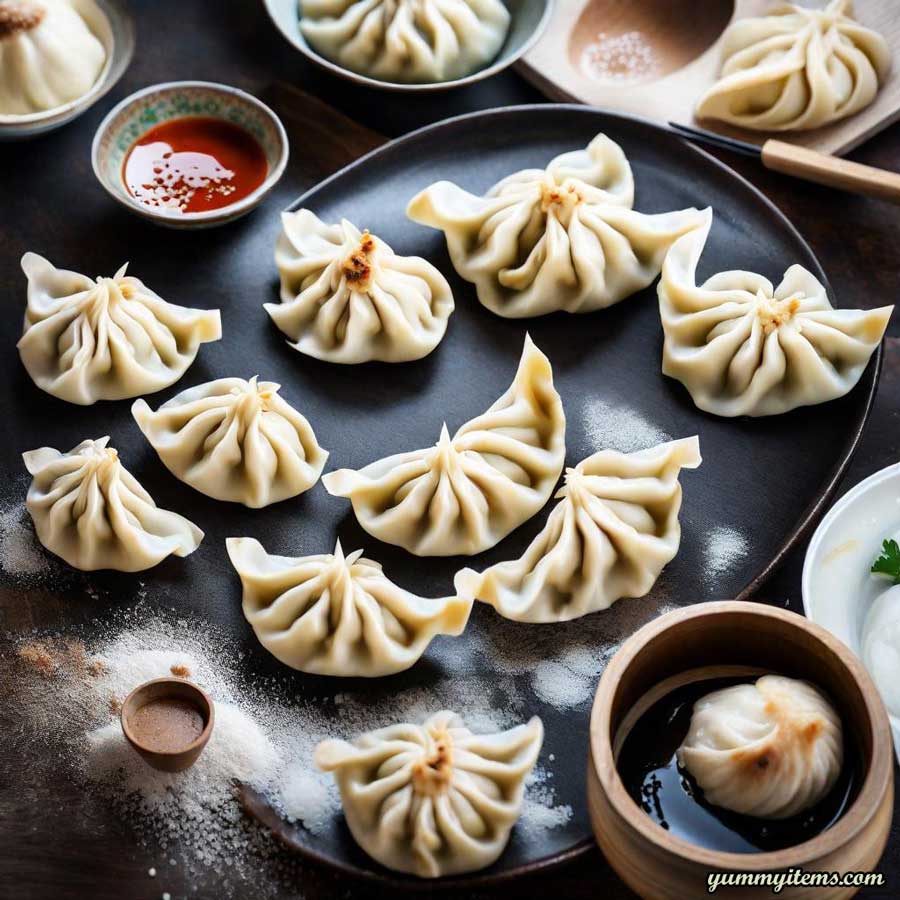
Dumplings offer endless possibilities when it comes to fillings. Whether you prefer savory or sweet dumplings, there’s a filling that’s sure to please your taste buds. Here are some delicious options:
Savory Fillings
- Pork and Cabbage: A classic and savory choice featuring ground pork, Napa cabbage, and seasonings.
- Shrimp and Chive: Delicate shrimp combined with fresh chives and a touch of garlic make for a delightful dumpling.
- Chicken and Mushroom: Tender chicken and earthy mushrooms create a flavorful filling.
- Vegetable Medley: A vegetarian option filled with a mix of colorful vegetables like carrots, bell peppers, and mushrooms.
- Beef and Scallion: Savory ground beef paired with vibrant green scallions and ginger.
- Spinach and Feta: A vegetarian option featuring sautéed spinach and creamy feta cheese.
Sweet Fillings
- Fruit Dumplings: Sweet and juicy fruits like apples, pears, or berries mixed with sugar and a hint of cinnamon.
- Chocolate and Banana: A decadent filling with chunks of chocolate and ripe banana slices.
- Nutella and Strawberry: Creamy Nutella paired with fresh strawberry slices for a luscious treat.
- Sweet Potato and Brown Sugar: Roasted sweet potato mashed with brown sugar and a pinch of cinnamon.
- Pumpkin Pie Dumplings: Pumpkin puree combined with brown sugar and pumpkin spice for a delightful fall-inspired filling.
Feel free to get creative with your fillings by combining different ingredients to suit your palate. Once you’ve chosen your filling, it’s time to start filling and folding your dumplings.
7. Cooking Dumplings
Now that your dumplings are expertly filled and folded, it’s time to cook them to perfection. Dumplings can be prepared using various cooking methods, each offering a unique texture and flavor. Here are three common ways to cook dumplings:
Boiling Dumplings
Boiling dumplings is a straightforward method that yields tender, juicy dumplings with a soft wrapper. Here’s how to do it:
Ingredients and Tools:
- Filled dumplings
- Large pot of boiling water
- Slotted spoon
Instructions:
- Bring Water to a Boil: Fill a large pot with water and bring it to a rolling boil.
- Add Dumplings: Carefully drop the filled dumplings into the boiling water. Stir gently to prevent sticking.
- Cook Until They Float: Allow the dumplings to cook until they float to the surface. This usually takes about 3-5 minutes, but it may vary depending on the size of your dumplings.
- Cook a Bit Longer: Once the dumplings have floated to the top, continue to cook for an additional 1-2 minutes to ensure they are fully cooked through.
- Remove and Serve: Use a slotted spoon to remove the dumplings from the boiling water. Drain any excess water, and they’re ready to be served.
Boiled dumplings are often enjoyed with a dipping sauce made from ingredients like soy sauce, vinegar, and sesame oil.
Steaming Dumplings
Steaming dumplings results in a lighter, slightly translucent wrapper with a soft, doughy texture. Here’s how to steam dumplings:
Ingredients and Tools:
- Filled dumplings
- Bamboo or metal steamer
- Steamer liner or parchment paper
Instructions:
- Prepare the Steamer: Line the steamer trays with steamer liners or parchment paper to prevent sticking.
- Arrange Dumplings: Place the filled dumplings in the steamer trays, making sure they are not touching each other.
- Steam Dumplings: Fill a large pot or wok with water and bring it to a simmer. Place the steamer trays over the simmering water, ensuring that the water does not touch the dumplings.
- Cover and Steam: Cover the steamer and allow the dumplings to steam for about 10-15 minutes. The exact steaming time may vary depending on the size and thickness of your dumplings. They are ready when the wrapper becomes translucent and the filling is fully cooked.
- Remove and Serve: Carefully remove the steamed dumplings from the steamer trays and serve hot.
Steamed dumplings pair wonderfully with dipping sauces like a soy-based sauce with garlic and ginger.
Pan-Frying Dumplings (Potstickers)
Pan-frying dumplings, also known as potstickers, creates a delightful combination of crispy bottoms and tender, chewy tops. Here’s how to pan-fry dumplings:
Ingredients and Tools:
- Filled dumplings
- Non-stick or cast-iron skillet
- Cooking oil
- Water
Instructions:
- Heat Oil: Place a non-stick or cast-iron skillet over medium-high heat. Add a couple of tablespoons of cooking oil and heat until it shimmers.
- Add Dumplings: Carefully place the filled dumplings in the hot oil, ensuring they are not touching. Allow them to cook undisturbed for 1-2 minutes or until the bottoms turn golden brown.
- Add Water and Cover: Once the bottoms are crispy and golden, carefully add about 1/4 cup of water to the skillet. Quickly cover the skillet with a lid to trap the steam.
- Steam and Crisp: Allow the dumplings to steam in the covered skillet for about 5 minutes. This steaming step ensures that the tops of the dumplings cook through.
- Remove the Lid: After steaming, remove the lid, and continue cooking the dumplings until all the water evaporates and the bottoms become crispy again. This should take an additional 2-3 minutes.
- Remove and Serve: Use a spatula to carefully lift the pan-fried dumplings from the skillet. Serve them with the crispy side up.
Pan-fried dumplings are often served with a dipping sauce that combines the flavors of soy sauce, vinegar, and sesame oil.
8. Sauces and Dipping Options
Dumplings are typically enjoyed with a variety of dipping sauces that enhance their flavors. While there are numerous pre-made sauces available in stores, creating your own homemade dipping sauces can take your dumpling experience to the next level. Here are some popular dipping sauce options:
Homemade Dumpling Sauces
- Soy and Vinegar Dip: Combine soy sauce with rice vinegar for a classic, savory dipping sauce. Add a touch of minced garlic or ginger for extra flavor.
- Soy and Sesame Dip: Mix soy sauce with sesame oil and a pinch of sugar for a nutty, savory sauce. Garnish with sesame seeds or chopped scallions.
- Spicy Chili Oil Dip: If you enjoy a little heat, drizzle your dumplings with homemade or store-bought chili oil. You can adjust the spiciness by adding more or less oil.
- Peanut Sauce: Whisk together peanut butter, soy sauce, rice vinegar, sugar, and a splash of water for a creamy and savory dip.
- Sweet and Sour Dip: Combine vinegar, sugar, and ketchup for a tangy and sweet dipping sauce with a hint of umami.
- Sesame-Ginger Dip: Create a zesty dip by mixing together soy sauce, minced ginger, sesame oil, and a touch of honey.
Feel free to adjust the ingredients and proportions to suit your taste preferences. Dipping sauces can be as simple or as complex as you like.
9. Troubleshooting and Tips
While making dumplings with just flour and water is relatively straightforward, there can still be some challenges along the way. Here are some common issues and expert tips to help you achieve perfect dumplings:
Common Dough and Filling Issues
- Dough Too Dry: If your dough is too dry and crumbly, add a small amount of water, a teaspoon at a time, and knead it until the dough becomes smooth and elastic.
- Dough Too Sticky: If your dough is too sticky and difficult to work with, add a bit more flour, a tablespoon at a time, and knead until the dough reaches the right consistency.
- Wrappers Tear Easily: If your dumpling wrappers tear when you fold them, it may be due to overfilling. Use less filling, and make sure the edges of the wrapper are properly sealed.
- Filling Leaks: To prevent filling from leaking during cooking, make sure the dumplings are sealed tightly. Pinch the edges of the wrapper firmly to create a secure seal.
- Dumplings Stick to the Pan: When pan-frying dumplings, make sure your skillet is well-greased and hot before adding the dumplings. This will help prevent sticking.
Expert Tips for Perfect Dumplings
- Consistent Wrapper Thickness: When rolling out dumpling wrappers, aim for consistent thickness throughout to ensure even cooking.
- Flour for Dusting: Dust your work surface and rolling pin with a little flour to prevent the dough from sticking.
- Keep Dumplings Covered: While shaping dumplings, cover any dough or finished dumplings with a kitchen towel to prevent them from drying out.
- Practice Makes Perfect: Shaping dumplings may take a bit of practice, so don’t be discouraged if your first few attempts are less than perfect. The taste is what matters most!
- Cooking Variations: Experiment with different cooking methods and discover your favorite way to enjoy dumplings—boiled, steamed, or pan-fried.
10. Dumplings Around the World
Dumplings are a global culinary phenomenon, and they take on various forms and flavors in different parts of the world. Let’s explore some regional variations of dumplings that showcase the diverse and delicious world of dumpling-making:
Chinese Dumplings (Jiaozi)
Chinese dumplings, known as “jiaozi,” are a staple in Chinese cuisine and are traditionally enjoyed during the Chinese New Year. These dumplings are often filled with a mixture of ground meat, such as pork or chicken, combined with vegetables like Napa cabbage and green onions. They can be boiled, steamed, or pan-fried, and their shape often features pleats and folds that symbolize wealth and prosperity.
Japanese Dumplings (Gyoza)
In Japan, dumplings are referred to as “gyoza,” and they are typically filled with a mixture of ground pork, cabbage, garlic, and ginger. Gyoza are commonly pan-fried to achieve a crispy bottom while keeping the tops tender. They are served with a dipping sauce made from soy sauce, rice vinegar, and chili oil. Gyoza are a popular appetizer or snack in Japanese cuisine.
Korean Dumplings (Mandu)
Korean dumplings, known as “mandu,” come in various forms, including fried, steamed, or boiled. They can be filled with a wide range of ingredients, such as beef, pork, tofu, and kimchi. Mandu often feature a half-moon shape and are enjoyed with a dipping sauce made from soy sauce, vinegar, and sesame oil.
Polish Dumplings (Pierogi)
Pierogi are beloved dumplings in Polish cuisine, and they come in both savory and sweet varieties. Traditional savory pierogi fillings include potatoes, cheese, meat, and sauerkraut. Sweet pierogi can be filled with fruits like cherries, strawberries, or blueberries, and they are often served with a dollop of sour cream or a sprinkle of sugar.
Russian Dumplings (Pelmeni)
Russian pelmeni are small, meat-filled dumplings typically made with a mixture of ground pork and beef. These dumplings are served with sour cream or a generous amount of butter. Pelmeni can be boiled and served in a clear broth or pan-fried for a crispy texture.
Indian Dumplings (Momo)
In India, momo dumplings are a popular street food and snack. These dumplings can be filled with a variety of ingredients, including spiced ground meat, vegetables, or cheese. Momos are typically steamed or pan-fried and are served with a spicy tomato-based sauce.
These are just a few examples of the diverse world of dumplings, and each culture adds its own unique flavors and techniques to this beloved comfort food.
Ref: https://www.wikihow.com/Make-Flour-Dumplings
11. Conclusion
Congratulations! You’ve completed your comprehensive guide to making dumplings with just flour and water. You’ve learned how to prepare the dough, shape dumplings with various fillings, and cook them using different methods. Whether you prefer your dumplings boiled, steamed, or pan-fried, you now have the skills to create delicious dumplings at home.
Dumplings are a testament to the versatility of flour and water in the culinary world. They offer a world of possibilities when it comes to fillings, flavors, and folding techniques. So, gather your ingredients, roll out that dough, and let your creativity flow as you craft your very own dumplings.
Whether you’re enjoying dumplings as a comforting family meal, a casual snack, or a gourmet treat, the process of making them is a labor of love that brings people together. So, share your dumplings with loved ones, savor every bite, and take pride in your newfound dumpling-making skills.
Now, it’s time to roll up your sleeves, get into the kitchen, and embark on your dumpling-making adventure. Happy dumpling-making, and may your creations be deliciously satisfying!

